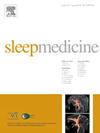Longitudinal analysis of the bidirectional relationship between screen time and sleep: Exploring the role of physical activity
IF 3.8
2区 医学
Q1 CLINICAL NEUROLOGY
引用次数: 0
Abstract
Background
Excessive screen time and poor sleep duration have significant implications for children's health and well-being. Understanding the dynamic relationship between screen time and sleep duration, as well as the impact of physical activity in this relationship, is essential for promoting healthy behaviours. The aims of this study were to: 1) investigate the bidirectional relationship between screen time and sleep duration in children, and 2) explore the mediating role of physical activity in these associations.
Methods
Data were from 2064 children (47 % girls) who responded to time-use diaries at waves 3 (age 5), 6 (age 10), and 7 (age 12) of the Longitudinal Study of Australian Children (LSAC). Cross-lagged panel modelling was conducted to test bidirectional associations between screen time and sleep duration, with the mediating role of physical activity assessed using a lagged mediation model.
Results
A bidirectional association between screen time and sleep duration across ages 10 to 12 was observed. Screen time at 10 years of age was associated with sleep duration at 12 years of age (β = −0.071 [95%CI, −0.114 to −0.015]), and sleep duration at 10 years of age was associated with screen time at 12 years of age (β = −0.048 [95%CI, −0.087 to −0.002]). Moreover, increased levels of physical activity at age 12 reduced the negative impact of both screen time on sleep duration and sleep duration on screen time during the ages of 10 and 12.
Conclusion
Findings highlight a cyclical influence where each factor impacts the other over time. Interventions aimed at reducing screen time and increasing physical activity may help mitigate the negative effects of excessive screen time on sleep.
屏幕时间与睡眠之间双向关系的纵向分析:探索体育活动的作用。
背景:屏幕时间过长和睡眠时间不足对儿童的健康和福祉有重大影响。了解屏幕时间和睡眠时间之间的动态关系,以及身体活动在这种关系中的影响,对于促进健康行为至关重要。本研究的目的是:1)研究儿童屏幕时间与睡眠时间之间的双向关系,2)探索体育活动在这些关联中的中介作用。方法:数据来自2064名儿童(47%为女孩),他们在澳大利亚儿童纵向研究(LSAC)的第3期(5岁)、第6期(10岁)和第7期(12岁)对时间使用日记有反应。交叉滞后面板模型用于测试屏幕时间和睡眠时间之间的双向关联,并使用滞后中介模型评估身体活动的中介作用。结果:在10到12岁的孩子中,屏幕时间和睡眠时间之间存在双向关联。10岁时的屏幕时间与12岁时的睡眠时间相关(β = -0.071 [95%CI, -0.114至-0.015]),10岁时的睡眠时间与12岁时的屏幕时间相关(β = -0.048 [95%CI, -0.087至-0.002])。此外,12岁时体育活动水平的增加减少了10岁和12岁时屏幕时间对睡眠时间和睡眠时间对屏幕时间的负面影响。结论:研究结果强调了一种周期性影响,即每个因素随着时间的推移影响另一个因素。旨在减少屏幕时间和增加身体活动的干预措施可能有助于减轻屏幕时间过长对睡眠的负面影响。
本文章由计算机程序翻译,如有差异,请以英文原文为准。
求助全文
约1分钟内获得全文
求助全文
来源期刊

Sleep medicine
医学-临床神经学
CiteScore
8.40
自引率
6.20%
发文量
1060
审稿时长
49 days
期刊介绍:
Sleep Medicine aims to be a journal no one involved in clinical sleep medicine can do without.
A journal primarily focussing on the human aspects of sleep, integrating the various disciplines that are involved in sleep medicine: neurology, clinical neurophysiology, internal medicine (particularly pulmonology and cardiology), psychology, psychiatry, sleep technology, pediatrics, neurosurgery, otorhinolaryngology, and dentistry.
The journal publishes the following types of articles: Reviews (also intended as a way to bridge the gap between basic sleep research and clinical relevance); Original Research Articles; Full-length articles; Brief communications; Controversies; Case reports; Letters to the Editor; Journal search and commentaries; Book reviews; Meeting announcements; Listing of relevant organisations plus web sites.
 求助内容:
求助内容: 应助结果提醒方式:
应助结果提醒方式:


